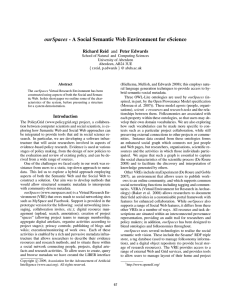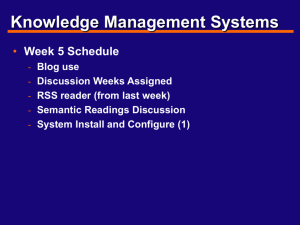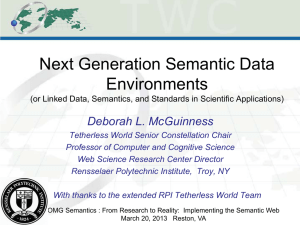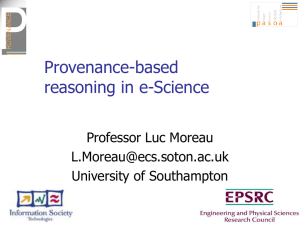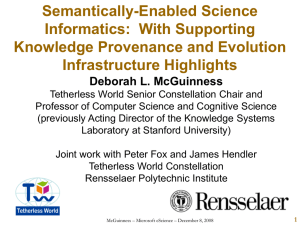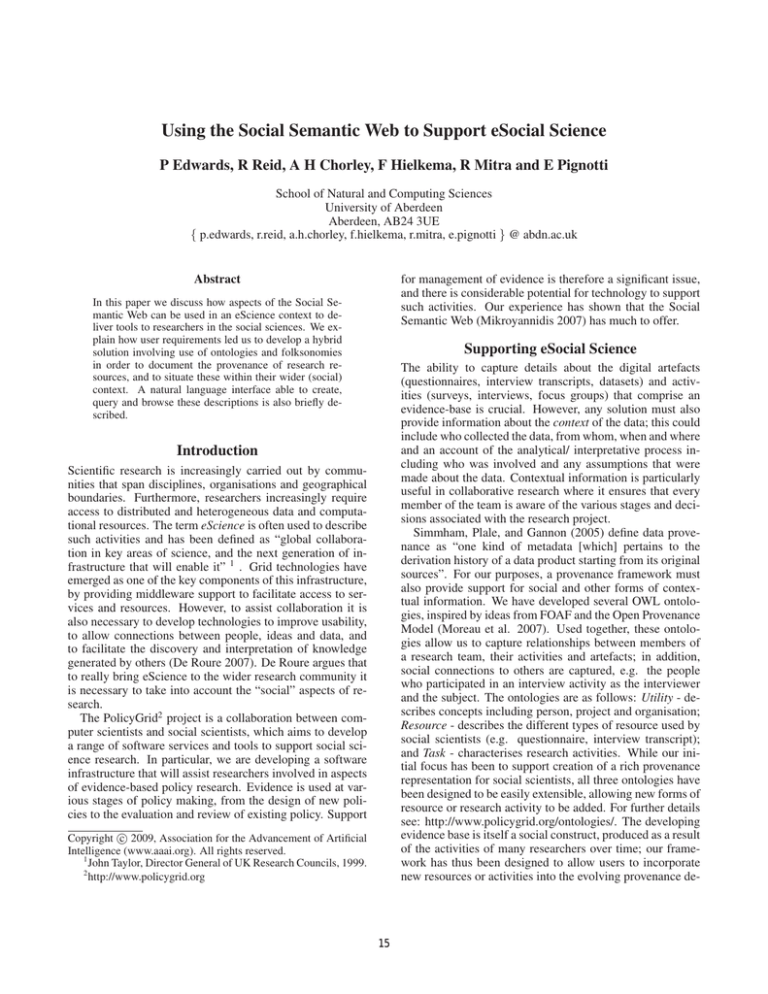
Using the Social Semantic Web to Support eSocial Science
P Edwards, R Reid, A H Chorley, F Hielkema, R Mitra and E Pignotti
School of Natural and Computing Sciences
University of Aberdeen
Aberdeen, AB24 3UE
{ p.edwards, r.reid, a.h.chorley, f.hielkema, r.mitra, e.pignotti } @ abdn.ac.uk
for management of evidence is therefore a significant issue,
and there is considerable potential for technology to support
such activities. Our experience has shown that the Social
Semantic Web (Mikroyannidis 2007) has much to offer.
Abstract
In this paper we discuss how aspects of the Social Semantic Web can be used in an eScience context to deliver tools to researchers in the social sciences. We explain how user requirements led us to develop a hybrid
solution involving use of ontologies and folksonomies
in order to document the provenance of research resources, and to situate these within their wider (social)
context. A natural language interface able to create,
query and browse these descriptions is also briefly described.
Supporting eSocial Science
The ability to capture details about the digital artefacts
(questionnaires, interview transcripts, datasets) and activities (surveys, interviews, focus groups) that comprise an
evidence-base is crucial. However, any solution must also
provide information about the context of the data; this could
include who collected the data, from whom, when and where
and an account of the analytical/ interpretative process including who was involved and any assumptions that were
made about the data. Contextual information is particularly
useful in collaborative research where it ensures that every
member of the team is aware of the various stages and decisions associated with the research project.
Simmham, Plale, and Gannon (2005) define data provenance as “one kind of metadata [which] pertains to the
derivation history of a data product starting from its original
sources”. For our purposes, a provenance framework must
also provide support for social and other forms of contextual information. We have developed several OWL ontologies, inspired by ideas from FOAF and the Open Provenance
Model (Moreau et al. 2007). Used together, these ontologies allow us to capture relationships between members of
a research team, their activities and artefacts; in addition,
social connections to others are captured, e.g. the people
who participated in an interview activity as the interviewer
and the subject. The ontologies are as follows: Utility - describes concepts including person, project and organisation;
Resource - describes the different types of resource used by
social scientists (e.g. questionnaire, interview transcript);
and Task - characterises research activities. While our initial focus has been to support creation of a rich provenance
representation for social scientists, all three ontologies have
been designed to be easily extensible, allowing new forms of
resource or research activity to be added. For further details
see: http://www.policygrid.org/ontologies/. The developing
evidence base is itself a social construct, produced as a result
of the activities of many researchers over time; our framework has thus been designed to allow users to incorporate
new resources or activities into the evolving provenance de-
Introduction
Scientific research is increasingly carried out by communities that span disciplines, organisations and geographical
boundaries. Furthermore, researchers increasingly require
access to distributed and heterogeneous data and computational resources. The term eScience is often used to describe
such activities and has been defined as “global collaboration in key areas of science, and the next generation of infrastructure that will enable it” 1 . Grid technologies have
emerged as one of the key components of this infrastructure,
by providing middleware support to facilitate access to services and resources. However, to assist collaboration it is
also necessary to develop technologies to improve usability,
to allow connections between people, ideas and data, and
to facilitate the discovery and interpretation of knowledge
generated by others (De Roure 2007). De Roure argues that
to really bring eScience to the wider research community it
is necessary to take into account the “social” aspects of research.
The PolicyGrid2 project is a collaboration between computer scientists and social scientists, which aims to develop
a range of software services and tools to support social science research. In particular, we are developing a software
infrastructure that will assist researchers involved in aspects
of evidence-based policy research. Evidence is used at various stages of policy making, from the design of new policies to the evaluation and review of existing policy. Support
c 2009, Association for the Advancement of Artificial
Copyright Intelligence (www.aaai.org). All rights reserved.
1
John Taylor, Director General of UK Research Councils, 1999.
2
http://www.policygrid.org
15
Discussion
scription through such community action.
Our work to date has shown that there is considerable potential within eScience for the use of a mixed solution combining aspects of the Semantic Web and the Social Web. Our
users were comfortable with the use of a formal representation to capture the structure of the evidence base, but desired a lightweight, community-driven approach to provide
content. While we have explored some aspects of the Social
Semantic Web to date, much still remains to be done. For
example, we have yet to implement a solution to deal with
the issues of trust and reputation. This clearly plays a vital
role in the research process and our social provenance graph
should provide a starting point for extensions to document
the reputation of an individual or a resource. Extensions to
the social provenance graph are also needed to incorporate
spatial information and to provide better support for temporal context. Finally, a mechanism to allow the community of
researchers to develop new resource and task descriptions is
required; the LIBER interface already provides some facilities of this kind, but they are not designed to be driven by a
group of users.
While the ontologies provide a means for us to capture
the structure of the social provenance graph, they do not
attempt to characterise domain concepts that might feature
within resource or task descriptions. As social science concepts emerge from debate and are open to indefinite modification through debate, vocabularies tend to be imprecise and
mutable - vocabularies tend to change over time to reflect
shifts in understanding of social reality (Edwards, Aldridge,
and Clarke 2006). Our solution, therefore, is to use ontologies to provide a “conceptual scaffold” for lightweight
metadata. In other words, ontologies are used to capture
the structure of the social graph, including resources, activities and project descriptions; folksonomies then provide
the community-driven mechanism to support the development of domain vocabularies. We believe that this approach
provides social scientists with a flexible and open-ended
means of describing resources and activities, whilst at the
same time providing a context for those assertions through
more structured concepts. Permitted values for many of the
datatype properties within the ontologies are of type ‘string’
and it is here that users may enter tag data; as users describe their resources, an underlying folksonomy is constructed which can be used to guide others towards popular
tag choices. These folksonomies are kept separate because
different values apply to different properties; the property
hasCountry for example, has rather different tags associated with it than hasSamplingMethod. This enables us
to generate contextualised tag clouds such as a cloud for a
particular property, or for a particular project. Our approach
has much in common with Gruber (2006), who has argued
that technologies such as OWL and RDF should act as a
“substrate for collective intelligence”.
Acknowledgements
The authors acknowledge financial support provided by the
UK Economic and Social Research Council (ESRC) under
the eSocial Science programme; grant reference RES-14925-1027.
References
De Roure, D. 2007. The New e-Science. IEEE e-Science
Conference, Bangalore.
Edwards, P.; Aldridge, J.; and Clarke, K. 2006. A Tree Full
of Leaves: Description Logic and Data Documentation. In
Proceedings of the Second International Conference on eSocial Science.
Gruber, T. 2006. Where the Social Web meets the Semantic
Web. In Proceedings of the Fifth International Semantic
Web Conference (ISWC 2006), volume 4273, 994. Springer
Lecture Notes in Computer Science.
Hielkema, F.; Mellish, C.; and Edwards, P. 2008. Evaluating an Ontology-Driven WYSIWYM Interface. In Proceedings of the Fifth International Conference on Natural
Language Generation.
Mikroyannidis, A. 2007. Toward a Social Semantic Web.
IEEE Computer 40:113–115.
Moreau, L.; Freire, J.; Futrelle, J.; McGrath, R.; Myers, J.; and Paulson, P. 2007. The Open Provenance
Model. Technical Report, ECS, University of Southampton, http://eprints.ecs.soton.ac.uk/14979/1/opm.pdf.
Reid, R., and Edwards, P. 2009. ourSpaces - A Social Semantic Web Environment for eScience. In Papers from the
AAAI Spring Symposium on Social Semantic Web: Where
Web2.0 Meets Web3.0.
Simmham, Y.; Plale, B.; and Gannon, D. 2005. A Survey
of Data Provenance in eScience. ACM SIGMOD Record
34(3):31–36.
The use of such a representation creates a number of
user-interface challenges: How will users create RDF when
describing an element within the social provenance graph?
How should presentation of folksonomies be integrated with
tools for RDF creation and query construction? LIBER
(Hielkema, Mellish, and Edwards 2008). is an integrated
metadata browser, editor and query tool based on the use
of natural language generation techniques. It has been designed to enable users with little or no previous experience
of semantic technologies to interact with our hybrid metadata representation. The browser presents natural language
representations of the provenance graph; the query module
enables the user to create SPARQL queries which act upon
the graph; and the editing module is used to create metadata.
When the user is prompted to provide a value, tag clouds are
used to present an overview of the tags popular amongst the
user community in that particular context. A feedback text
is also generated, so that the user can check whether what
was added was what he really meant.
As a platform for our investigations we are developing
ourSpaces, a virtual research environment (VRE) that allows
users to upload, store and annotate scientific resources in a
collaborative workspace (Reid and Edwards 2009).
16

